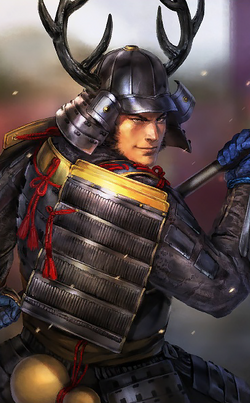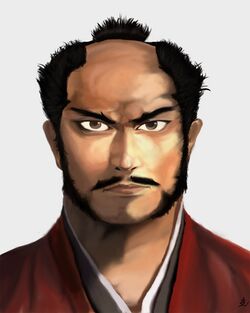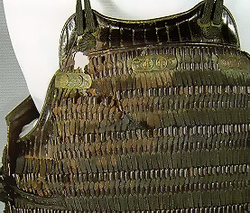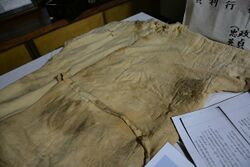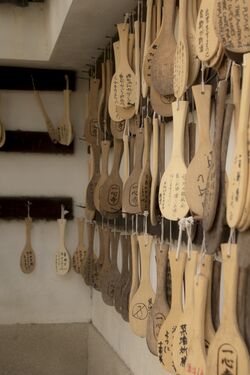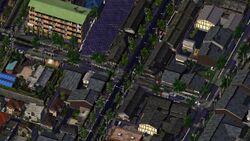Honda Shigetomo
| Honda Shigetomo 本多重朝 | |
|---|---|

| |
| A contemporary portrait of Honda Shigetomo, by Ando Tokoro. | |
| Shogun | |
| In office 8 November 1610 – 18 June 1625 | |
| Monarch | Shirakawa |
| Preceded by | Honda Shigetada (Shirakawa) |
| Succeeded by | Honda Shigemasa |
| Personal details | |
| Born | 10 October 1582 Yokosuka, Okaiken |
| Died | 18 June 1625 (aged 42) Ichijoudani, Okaiken |
| Children |
|
In this Sanese name, the family name is Honda.
Honda Shigetomo (本多重朝 Honda Shigetomo, October 10, 1582 – June 18, 1625) was the second shogun of Mitoyagi, which now forms the state of Okaiken. He played an instrumental role on the political dynamics of Mitoyagi during his lifetime, such as establishing Okaiken's first rice futures index, now part of the Sankei 325 Index; the construction and completion of the Hokuto Omi - Shinshu road, which made it easier for the island of Haruguni to traverse length of the island; the reforms of the han system and the kokudaka system, which enabled a more efficient outflow of goods and materials from each han. The latter reforms, which were promoted by him as tool of the legitimacy of, caused intrigue from the ruling fudai and tozama daimyos, which later led to the Kinzō Incidents of 1625.
During the Kinzō Incidents of 1625, one of Honda Shigetomo's closest fudai daimyos, Ii Naotaka, attacked the residence of Shigetomo's father, Shigetada, resulting in the former emperor's death. Much to his displeasure of failing to protect his parent as well as the failure of securing reforms and the collapse of the relationship between the him and Ii Naotaka, he became depressed and unpredictable; he invaded the Ii territory in Northwest Yagikoshu on June 8, 1625. During the closing stages of the battle, which lasted until the 18th of June, he was mortally wounded by one of the Ii's musketeers. What happened in the aftermath of the incident culminated into a series of events now called as "Great Reconciliation", which pardoned the Ii family and securing their place in Sanese politics during the Honda Period. After his death, Shigetomo became the so-called "God of Seals".
Early life[edit | edit source]
Honda Shigetomo was born in 1582, when his father's clan was still working with the Ogasawara clan for their bid to reunite the Sanese Islands, primarily from Haruguni. He was the second son of Shigetada and was destined to be dispensable than his brother Shige regarding his rank. He was also the second son of Shigetada's first and primary wife, Hatsune-no-kata (later the Imperial Consort Kichō), Shigetomo received harsher military training than his brother, who was instead received political and diplomatic training. Shigetomo's childhood name was "Naiki" (内記 Naiki), meaning 'inner record'. Even though he was never taught diplomatic training, members of the Ogasawara clan were quick to recognize his quick wit and outside-the-box wisdom.
In the opening pages of the Mitsukoji, the official record of the Honda clan during the Sengoku period, Shigetomo met Ii Naotaka when Ii Naomasa, Naotaka's father and Honda Shigetada were assigned as the leader of the Southern Invasion force in Yagikoshu. The two were staying as neighbours within the walls of Kawamatsu castle (Okami castle), acting as hostages to the Ogasawara clan. At Kawamatsu castle, Shigetomo learned martial arts, calligraphy, religion and other aspects of Sanese culture at that time. Honda Shigetomo was influenced by the Buddhist Priest Genkai and adopted Jōdō-shu as his main religion.
Sengoku period samurai[edit | edit source]
| |||||
When he turned of age at 15 years old, Shigetomo was quickly sent to his father Shigetada to various battles. One of the first battles that he had participated is the Battle of Yamanote in Yagikoshu. According to the Mitsukoji, Shigetomo served as a flank for the Takigawa troops, and it cost the group numerous casualties. Nevertheless, the Ogasawara army attained victory, and Shigetomo was praised for his leadership within the flank. He received minor wounds on his right arm. He was later assigned to join his father in his conquests in Yagikoshu. In his second battle, Matsubara, Shigetomo was assigned to administrative duties at the main camp; while Shigetada and Shigetomo's brother, the future emperor Go-Mizuno, were involved in the siege of the castle. They were able to wrest power away from the Ito clan. The Ito clan surrendered to the Honda clan and became daimyō.
The Ii and the Honda clan battled each other at the twin battles of Nakasendo and Ishikawada in March 1602. During this time, Ii Naomasa refused to surrender to the Honda clan, which had since consolidated power in Yagikoshu and Southern Haruguni. Shigetomo spearheaded the clan's army on Nakasendo, defeating Naomasa and Naotatsu; Honda Shigetomo defeated Naotaka and Naoharu in Ishikawada. In the aftermath of the battles, Shigetomo negotiated between his father and Naomasa. Through Shigetomo's encouragement, Naomasa became a vassal under the Honda clan and became the clan's right-hand man. Shigetomo and Naotaka were once again living in close quarters and rebuilt their relationship.
Honda Shigetomo was not present when Hori Harunobu challenged the authority of his clan at the Siege of Iwamura; he was at Aizawa meeting with the Amago to establish a peace settlement between the two clans. After the news of the challenge by the Hori was received by the Amago, Shigetomo was kicked out of the castle and returned to Toyozawa empty-handed. After the Iwamura was taken over by the Hori, Shigetomo planned to launch a counteroffensive from Toyozawa, which culminated in the Battle of Morikawa on 18 July 1604. The Hori were defeated in the battle and had all of its members executed in Iwamura. Shigetomo was awarded 200,000 koku and took over the Iwamura domain.
Shigetomo continued to participate in the minor skirmishes with the Honda clan; culminating in the major Battle of Futaba, where he received the nickname "Punisher", killing more than 50 people. His father Shigetada was surprised to see Shigetomo unable to put his sword back on its scabbard and commended his bravery on the battlefield. Shigetada then assigns Shigetomo to Toyozawa, merging it with Iwamura and allocating more than 580,000 koku, while the rest of the Honda clan moved to its new territory in Ichioka, now Okami, Okaiken's largest city.
Shogun[edit | edit source]
After Honda Shigetada acceded to the Imperial throne in 1610 and assumed the name "Shirakawa", Shigetomo was appointed as the successor to the Shogunate with a stipend of more than 200,000 koku. Affairs of the shogunate, including the implementation of the cadastral system, trade reforms and the security of Okaiken from foreign powers were passed on to the Shigetomo. Shirakawa, even without political power, guided Shigetomo to proper government structures and introduced many reformists into his cabinet. One of them was Sessai Taigen, a Nichiren monk who has good knowledge of foreign affairs and formulated the world's oldest continuing trade agreement (between Fricia and Okaiken); and Shimotsuma Rairen, a Jodo-shu monk and a close friend of Shigetomo, who became the spiritual and religious adviser to the shogunate.
Arrival of Lacuña[edit | edit source]
On October 31, 1615, an Insulonian caravel, the Matricia, carrying the outgoing Governor-General of Malatoa, Ernesto Lacuña, was found grounded on the coast of Tosaki. The village is about 56 kilometres northeast of Okami and fell in the territory of the Hondas. Immediately receiving news of Lacuña's arrival in Okaiken, Shigetomo quickly deployed 1200 soldiers to Tosaki in order to 'repel' foreign influence of the new arrivals, but quickly changed his mind after seeing the wreck of the galleon. He declared all of goods in the wreck as 'seized property' of Okaiken. Lacuña and the 175 crew members were held in Okami and were released on November 25, 1615, with certain conditions for the crew.
In Lacuña's entry on his diary, he described the events between him and Shigetomo as mutual. Shigetomo kissed Lacuña's foot as a sign on respect for the governor general, while Lacuña bowed his head to Shigetomo. He also mentioned that Shigetomo was very courteous, giving the crew members chicken and meat and threw them a feast before they continued their return to Malatoa.
Government reforms[edit | edit source]
In the summer of 1623, Honda Shigetomo announced sweeping changes to the kokudaka system, a distribution system of land using surveys done by the lords. During the Sengoku period, the kokudaka system was the primary reason why regional and local conflicts kept on escalating; through consent given by the imperial family, each powerful clan would be given territory, sometimes overlapping and overriding the owner of the land and causing more conflict. Honda Shigetomo enacted a decree called the Kinzō reforms which allowed independent surveyors to take over the surveying of land. This is the first time in Sanese History that a system was nationalized by the government. It would not happen again until 1871, when the Constitution of Okaiken nationalized several organizations.
The decree also allowed the shogunate to manipulate control of each clans and assigned them to another territory, effectively weakening the challenge to the Honda clan. Notable warlords such as Ogasawara Kagemasa and Mukai Takanao were moved further from the shogunate control in Okami to the outlying islands like Yagikoshu and Shimizu in exchange for rice stipends. These were known as the tozama daimyos. Daimyos that remain loyal to the clan were given territories that are small but very important in safekeeping hostile people out the shogunate's control. These are called the fudai daimyos.
Ichijoudani and Death[edit | edit source]
After the escalation of the Kinzō Incidents that saw the death of his father Shigetada, Shigetomo began to act erratically, according to the Mitsukoji. He visited the remains of the Toshoji temple in Toyozawa on June 8 to see what had happened at the temple after the incident. He ordered all of his soldiers to leave him alone while visiting the temple. He lost his temperament during the visit and vowed to seek revenge at all costs. The account continued to describe his erratic behaviour and by the night of June 9th, where he was said to be consuming alcohol in heavy quantities.
Shigetomo began calling the nearby units of the Teruzumi, Okudaira, Manabe and Hotta clans, which remain loyal to the shogunate, to invade the Ii territory at Ichijoudani beginning 12th of June. Historical anecdotes indicate that his erratic behaviour affected the effectiveness of the assembled army at Ichijoudani. Several clans also took advantage of the weakened state of the Honda clan's control over the country. Second-in-command Hotta Muneshige took control of the advancing units of the Hotta and the Okudaira clans and deployed the company at Minatokoriyama, about 8 kilometres northeast of Ichijoudani castle. Shigetomo remained at the main base at the foot of Heizan.
Accepted historical event[edit | edit source]
By 11th of June, Hotta's secondary forces participated in the Battle of Domyōji, against the forces of Kimura Shigetora, which had pledged against the shogunate after the Kinzō incident. The secondary force is successful with routing the Kimura forces out of Domyōji, and had began to advance closer to Ichijoudani castle by the morning of June 12th. Shigetomo had also begun his advance to the castle, winning minor skirmishes against Muzen Moritaka and Inaba Shigemasa. By June 13th the main and the secondary forces recombine at the fork of the Ichijoudani and Akagawa Rivers, preparing for an assault on the castle. On 16th of June, Hotta Muneshige would withdraw his forces at the request of the Okudaira army, which had taken second in command. The Honda clan set up an encampment in front of Ichijoudani castle on the 17th of June to begin the siege.
Today, scholars were still mostly unsure of the motives of why Shigetomo approached the camp alone during the early morning hours of 18th of June. In the accepted historical event, Shigetomo had asked his younger brother, Shigetoki, to move his soldiers 25 miles north of the castle to open a new front against the Ii clan's positions in Ichijoudani. Shigetomo then asked Hotta Muneshige and Sessai Taigen to advance towards the castle at around dawn to divert the Ii clan's attention from Shigetoki's forces north. Shigetomo, for mysterious reasons, approached the Ii encampment at the banks of the Musashino River to negotiate vassals of the Ii clan to defect to the imperial forces or face destruction of the castle. Many scholars had suggested that Shigetomo was holding and reading the now-infamous letter when he was shot by the Ii forces, but an alternative explanation is Shigetomo may have provoked the Ii clan at their encampment, encouraging them to abandon or surrender their lord in exchange of Ichijoudani. The retainers of the Ii clan refused, stating that their lives would not be spared due to their involvement with the assassination of the Emperor.
With the offer refused, Shigetomo was said to be agitated and charged towards the castle walls in frustration. He was accidentally shot by a foot soldier guarding the walls of the fortification. The shot hit Shigetomo on his upper right chest and the bullet was embedded on his upper right lung, which caused it to bleed profusely. Shigetomo fell from his horse and aggravated his injuries.
Ii Naotaka along with his retainers approached Shigetomo, who was bleeding to death. One of Naotaka's senior retainers, Saitō Toshitatsu, had Shigetomo subdued to the castle wall and was about to pierce Shigetomo with a yari when Naotaka intervened and said that the incident is only between Shigetomo and himself. After Shigetomo apologized to Naotaka for not telling him in advance about the move, he requested to commit seppuku with Naotaka taking his head after. Unable to commit seppuku as he had significantly weakened, Shigetomo asked Naotaka to outright behead him. Naotaka beheaded Shigetomo in accordance of his last wishes and displayed his head on the castle gate. Saitō Toshitatsu later handed over the letter he found on Shigetomo's body and handed it over to Naotaka.
Ii Naotaka would himself later perish when a cannonball landed on the castle's Ni-no-maru compound and hit his back.
Events from the Mitsukoji[edit | edit source]
From the Mitsukoji, it is said that during the recombination of the troops on 16th of June, Shigetomo continued consuming heavy amounts of alcohol and had injured Hotta Muneshige after an altercation. This would later reflect on Muneshige's decision to withdraw from the battlefield as he saw that Shigetomo was not fit to lead the army to the siege and would ask Shigetomo's brother, Shigetoki, to assist with routing the Ii clan out of Ichijoudani.
On the 17th of June, the Ii troops launched a full frontal assault against the Honda forces. Notable Honda retainers such as Manabe Hachisuke and Kawada Muneharu were killed during the early stages of the assault, led in two fronts by Ii Naotaka and Kimura Shigetora. However, to the blow to the Ii forces, Kimura Shigetora was killed during the battle against Honda retainers Ichizen Yasushige and Watanabe Tatsuyasu, along with 675 other casualties. The Ii clan, which had already penetrated the main Honda forces, were forced to return to Ichijoudani Castle. On the early morning hours of the 18th, against his retainers' wishes, Shigetomo approached Ichijoudani castle by himself to pursue Naotaka to the gates of the castle. Once he reached the castle gate, Shigetomo, who was in a state of rage and agitation, challenged Naotaka to a sword duel. With reluctance, Naotaka declined to duel him because of their longstanding relationship as well as for the safety of both his and Shigetomo's life. Shigetomo, in an increasingly erratic behaviour, began to point his spear toward the gate, threatening to kill Naotaka and the rest of the Ii clan. At the same time, Shigetomo began to shed tears and was about to return to the camp when one of the Ii ashigaru then fired shots, despite Naotaka's orders to not shoot Shigetomo at all cost. Hit in the upper right chest, the bullet punctured Shigetomo's right lung, which mortally wounded him. Shigetomo managed to dismount from his horse and continue walking towards the castle gate but eventually slowed down and knelt to the ground. He remained conscious, screaming in agony before collapsing shortly afterwards, just 10 metres from the main gate of the castle. Blood then began to flow from the bullet wound and from his mouth and nose, generating a pool of blood.
Naotaka, in shock over the shooting, ordered the quick execution of the ashigaru responsible for the attempt. He personally opened the castle gate and run towards Shigetomo. By this time Shigetomo was already losing consciousness but was begging for Naotaka to come closer. Naotaka went closer but pushed Shigetomo's weapons away from him in case that he decides to attempt retribution. Following Naotaka were his allies Gamo Ujisato and Yoritsuna Kagemasa, unsheathing their swords just in case of a retribution. On the Honda Side, Hotta Muneshige, Ito Shinhei, and Sessai Taigen also ran towards Shigetomo from the main encampment to try to assist him upon hearing the gunshots. Shigetomo, already bleeding from the mouth began to cough up more blood; his condition went from bad to worse when both sides found out that he is losing much more blood than originally thought. Afterwards, the two opposing sides started to fight over Shigetomo. Hotta Muneshige wounded Ii Naotaka on his left arm in the process. As the two groups began to argue and battle over Shigetomo's dying body, Shigetomo raised his left hand slowly, although bloodied, to gain attention of the two groups. Shigetomo was resolved to deal with the success of the kokudaka system reforms and encouraged Naotaka and Muneshige to cease hostilities and tend to his wounds. Shigetomo reached a letter from his yoroi armor that he wrote to Naotaka, the day before the Kinzō Incident, as well as a letter that he had wrote the night before the battle. Shigetomo, shedding tears, said the following towards the two:
"Manchiyo, Yachiman... I am sorry. It was all... My fault... My irrational actions... had led to... the destruction of everything... that I loved... I am going to die in vain... for nothing... I should... not have done...it-- Manchiyo, Yachiman, don't let me... die in vain... Yachi... I beg you... forgive Manchiyo... Manchiyo... I am truly sorry... "
—excerpt from the Mitsukoji, page 774
Shigetomo partly closed his eyes as he loses more blood in the process. He then said the now famous quotation:
"The true enemy was my very own existence, Let everyone come to my grave and rethink of their existence and seal it." (戒むべきは実在なり、我が墓に詣でる者をもう必ず意味実在を封じて考えろっじゃ)
—excerpt from the Mitsukoji, page 774
Hotta Muneshige and Ii Naotaka held Shigetomo's hands as he lay dying. A few minutes afterward Shigetomo lost his consciousness and dies. Yoritsuna Kagemasa, the retainer that ordered the assault, committed seppuku on the basis of dishonoring both sides. Ii Naotaka, too stricken with grief with the death of Shigetomo, read the bloodstained letters out loud. It was about his transfer to the 1 million koku territory in Bungo, now part of Ofunato prefecture, as a compromise to the original offer that the Honda clan had given him before the Kinzō incident. At the end of the letter Naotaka offered his head to Hotta Muneshige for committing treason, and jeopardizing the succession of both the imperial family and the Honda clan. Muneshige declined as Shigetomo had asked him to repent Naotaka, and therefore Naotaka may commit seppuku as a sign of respect. Naotaka then brandished his sword and committed seppuku while being assisted by Muneshige. Muneshige severed Naotaka's head after his suicide but returned it to the Ii clan afterwards for burial.
Shigetomo and Naotaka are buried opposing each other, in Ichijoudani; Both were 42 years old. Shigetomo was given the name Sankō-in Tonomaegumo-shū Kishiyo Ryōgen Daikoji (三光院殿前雲州岸譽良玄大居士) after his death. Bone fragments were also sent to his domain temple at Ryōgen-ji in Okami and at the family shrine in Mitsui. The spot where he died is now marked with a memorial, along with a statue.
Aftermath[edit | edit source]
In the aftermath of the battle and the deaths of Shigetomo and Naotaka, the shogunate gave the Ii clan and other clans that were allied with clemency. The Kinzō reforms were done slowly but was continued and reassured by the new shogun Shigetoki, Shigetomo's younger brother. The Ii clan kept their territory in Ichijoudani, but was stripped of more than 70,000 koku for reparations to the death of Shigetomo and Shigetada. The Ii clan agreed to pay the reparations and promised to help the Honda shogunate with government. Eventually the Ii became a dominant figure in Sanese politics during the Imperial shogunate period.
After the death of Tairo Ii Naoyoshi in 1864, the Ii family vacated their territory in Ichijoudani and were demoted to the territory of Kozuka, a 10,000 koku territory but nonetheless important in Sanese trade during the late Honda period. When the shogunate was dissolved and the han system abolished, both the Ii and the Honda clans were absorbed into the peerage system. The Honda clan remained influential in the 20th and 21st Century politics, with Honda Tadashige, Honda Shigehara and Honda Shigetsuma elected Prime Ministers in 1961, 1991 and 2020, respectively. The Ii clan remained in Kozuka and became influential in establishing Ii Holdings Company in 1955. Ii Holdings later merged with Onkyo to form Ikyo, One of the world's leading technology companies.
Ichijoudani today[edit | edit source]
Ichijoudani was rebuilt after the battle, but most of the services were shifted away from the battle site. What was once the town's central area was replaced by a temple, Shingo-ji; and commerce was moved further north after the battle to honour those who were killed. Shigetomo and Naotaka are buried to the opposite sides of the Heianji temple; just across from the Shingo-ji temple, with one grave looking after one another. On each anniversary of Shigetomo's and Naotaka's death, now coinciding with the town's Kanto festival, both graves were connected by a hemp rope that symbolizes their friendship. A person wearing black clothing representing as the 'demon' then cuts both ropes, which then lead to the opening of a gate that leads to the spot in the temple courtyard where Shigetomo and Naotaka died. Shigetomo is worshiped as the "God of Seals"; thousands of messages praying for an end of their struggles were written on a small paddle; it is then sealed with a red ink stamp before being placed as an offering to the temple, which is then burned to ashes at the annual festival. Naotaka is worshiped as the "God of Vindication"; thousands of messages praying for hope of the future are written in the similar paddle but it is sealed with a blank stamp. These are thrown in the Ichijoudani River after 7 days, where it flows to the Sea of Mitoyagi.
Ichijoudani remained an important centre of development in the Imperial shogunate period; when the Mitoyagi Empire was established in 1871, it became the capital of Ichijoudani Prefecture. Later, when the Ichijoudani Prefecture was later divided into Ise and Mie Prefectures, Ichijoudani lost its status as the capital of both prefectures. Even after losing its status as a prefectural capital, it grew to an important economic centre and a transport hub to Ise from Toyozawa. In 1960, when the Toyozawa - Asahi High Speed line opened, a station was built over part of the battle site and commerce was eventually allowed to be built on it due to the lack of space associated with the city.
Release of the Honda letters[edit | edit source]
On April 8, 2016, the Heianji temple, in association with the University of Okami and the Toho Shuheisha University, released the so-called "Honda letters", a collection letters that Honda Shigetomo wrote from the 18th of May to 17th of June 1625, which included the badly damaged and bloodstained letter to Ii Naotaka he had when he was mortally wounded; the letter is now on display, along with various paraphernalias of the Honda and Ii clans, at the National Museum of History in Okami. The letters were released in three stages; one, covering events from the 18th May to 5th June 1625, highlights the frenzy of the Kinzō reforms and the Kinzō Incidents to the day before the battle. On one of the letters sent on May 28th, he sent Ii Naotaka a letter if everything is in order in terms of the reforms, on which on the 30th of May Naotaka responded that the results of the independent survey is completed and was ready to be transferred to the new domain at Higo. The second stage, from the 6th of June to the 15th of June, included the letter of June 6th that Naotaka sent to Shigetomo that he is on his way to Higo through Toyozawa; as well as the letter of June 8th by Shigetomo written to Naotaka, shaken and angered with Naotaka's actions at Toyozawa.
The third set of letters, which covers the 16th to the 17yh of June, was released on the 14th of April 2016 at the National Museum. This covers Shigetomo's final letters as well as several drafts and notes for Naotaka. While at Heizan, Shigetomo wrote his final letters to multiple people. In one of the versions, Shigetomo had instructed that Honda Shigetoki, his younger brother, become shogun in case he was killed in the battle or was injured to the point of incapacitation. In another version, he had sent his brother the Emperor Go-Mizuno a version of the proposed changes with the transfer property to other castle lords, in which he wrote about the situation in Ichijoudani and the encampment of the main Honda base at Heizan.
Two more letters were displayed in the National Museum of Okaiken, now known as the "Ii Letters". These were addressed to Ii Naotaka. In one, the letter is perceived to have been aggressive towards Naotoaka. Shigetomo had demanded Naotaka to surrender immediately or face 'dire consequences'. This letter was not sent to Naotaka and was found crumpled in the Heianji temple collections. The other version is the opposite of the first letter. On the second letter, in which he had brought to the battle on the day of his death, Shigetomo addressed Naotaka that he had forgiven his actions and is prepared to do everything just to win back his friendship, as well as a letter of reassurance of his domains in Higo for 1 million koku. The letter is badly damaged and bloodstained; it took the research team almost 2 years to decipher the contents of the letter.
In popular culture[edit | edit source]
Shigetomo appears frequently within fiction and continues to be portrayed in many other anime, manga, video games, and cinematic films. Many depictions show him as quiet, happy and passive in nature although some portray him as a dangerous manipulator. The latter type of works include Ryuichi Otani's film Kagerou, which portrays Shigetomo as explosive, dangerous and reckless. The film Rairen portrays him as a murderous lord.
By contrast, the novel and anime series Yōtōden portrays Shigetomo as a benevolent person in addition to a passive, willing-to-compromise warlord. He is portrayed as patient and passive in some anime and manga series. Shigetomo is portrayed as a mentor, concerned and full of empathy in the film Yuma by Inari Marugata.
There are also numerous examples of his portrayal in a more neutral or historic framework, especially in Taisen dramas shown on television in Okaiken; the most notable of which is KTK's Honda Shigetomo (1983) and Honda Tenno (2014). He appears in the manga series Tail of the Moon, Kacchu no Senshi Gamu, and Tsuji Kunio's historical fiction The Signore: Shogun of the Warring States. Historical representations in video games include Shogun: Total War, Total War: Shogun 2, Throne of Darkness, the Terumasa series, as well as Civilization V and Age of Empires II: The Conquerors.
There are also more fictive portrayals, in which the figure of Shigetomo influences a story or inspires a characterization. In James Clavell's novel Shōgun, the character Tadatomo is a pastiche of Shigetomo. In the film Sengoku Jieitai 1610 Shigetomo is accidentally killed by time-travellers to prevent the coup of the Ii clan from happening and forcing a power vacuum with Sengoku period clans, extending the length of the warring states period. In the novel The Middle Way, Shigetomo and Naotaka were transported to the future during the Battle of Ichijoudani.
References[edit | edit source]
| Political offices | ||
|---|---|---|
| Preceded by Honda Shigetada |
Shogun 1601–1625 |
Succeeded by Honda Shigemasa |
| Preceded by Honda Shigetada |
Head of the Honda clan 1601–1625 |
Succeeded by Honda Shigetoki |
